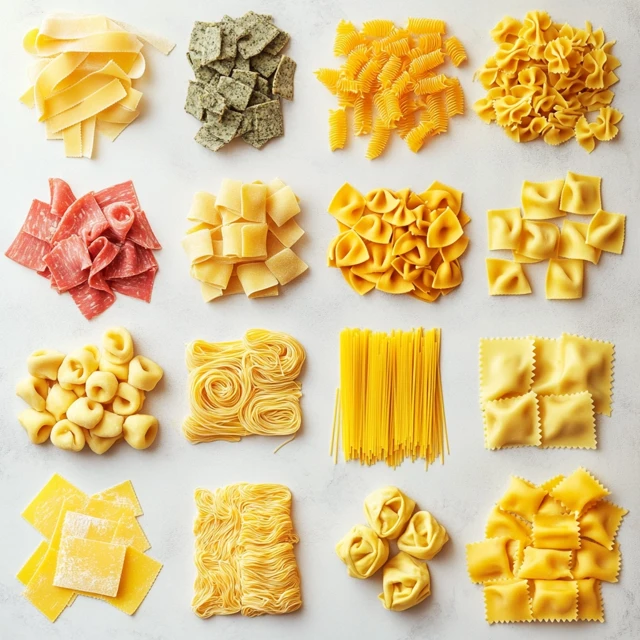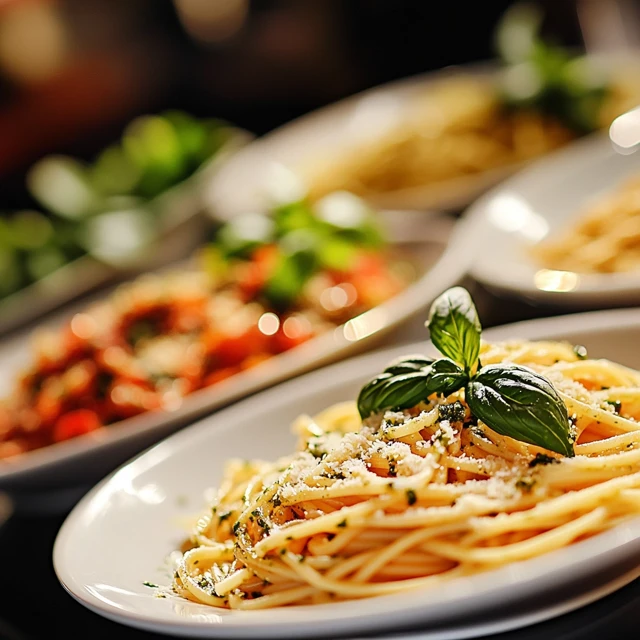Pasta is a beloved staple in many households around the world. Indeed, it comes in various shapes and textures, from delicate angel hair and hearty fettuccine to shell-shaped conchiglie and tube-like penne, with each type serving a specific purpose in different dishes. Moreover, whether you prefer long, tender spaghetti, short, ridged rigatoni, or delicately stuffed tortellini, understanding their distinctive differences can consequently help you make better choices in the kitchen. Therefore, this comprehensive guide will take you through the different types of pasta, their fascinating origins, and ultimately, the best ways to use them in your cooking.
Understanding the Different Types of Pasta

Pasta is far more than just a simple carbohydrate; rather, it stands as a remarkably versatile food with both a rich history and deep cultural significance. Therefore, as we delve deeper into this culinary cornerstone, let’s thoroughly explore not only its fascinating origins, but also its detailed classification, and furthermore, discover precisely why choosing the right type of pasta is fundamentally important for creating exceptional dishes.
check out this https://eassyrecipes.com/category/dinner/
What Is Pasta and Its Origins?
Pasta is fundamentally a dough-based food made primarily from wheat flour and water, while some notable varieties additionally include eggs, consequently enhancing both their texture and overall flavor.
Although the origins of pasta are widely debated, most historians nonetheless agree that it has deep roots in ancient civilizations. Interestingly, while popular legend credits Marco Polo with bringing pasta to Italy from China, compelling evidence suggests that, in fact, pasta existed in Italy long before his travels. For instance, ancient Romans regularly enjoyed a pasta-like dish called “lagana,” which remarkably resembled modern lasagna sheets.
Throughout the centuries, pasta gradually evolved into an incredibly diverse range of shapes and sizes, primarily influenced by regional traditions and locally available ingredients. Consequently, in modern times, pasta has become a universally beloved dish that is creatively enjoyed in countless ways across the globe.
check out this https://eassyrecipes.com/category/dinner/
How Pasta Is Classified by Shape and Texture
Pasta comes in hundreds of varieties, but it is commonly classified into four main categories based on shape and texture:
- Long Pasta: These are thin, string-like shapes that work well with light and creamy sauces. Examples include spaghetti, linguine, and fettuccine.
- Short Pasta: These pasta shapes are small and sturdy, ideal for holding thick sauces and baked dishes. Penne, rigatoni, and fusilli fall into this category.
- Stuffed Pasta: These are pasta sheets filled with cheese, meat, or vegetables. Ravioli, tortellini, and cannelloni are popular examples.
- Flat and Wide Pasta: These pasta types, such as lasagna and pappardelle, are used in layered dishes and rich sauces.
Each type of pasta interacts differently with sauces, which makes it essential to choose the right one for your recipe.
Why Choosing the Right Pasta Matters
Selecting the right pasta type can enhance the flavor and texture of a dish. Different sauces cling better to certain pasta shapes, and the right combination can elevate the overall dining experience.
- Light sauces work best with long, thin pasta, like spaghetti or linguine, as they evenly coat the strands.
- Thicker, chunky sauces pair well with short pasta, such as penne or rigatoni, because their hollow shape holds the sauce inside.
- Stuffed pasta needs delicate, lighter sauces to complement their rich fillings without overpowering them.
By understanding these differences, you can create balanced, flavorful pasta dishes every time.
Common Types of Pasta and Their Uses
Pasta comes in a wide variety of shapes, each with its own unique purpose. Some pasta types are better suited for creamy sauces, while others work well in hearty, tomato-based dishes.
Long Pasta Varieties
Long pasta is one of the most recognizable categories, perfect for dishes that require smooth, even coating of sauces. Let’s explore a few popular long pasta varieties.
Spaghetti
Spaghetti is perhaps the most well-known type of pasta worldwide. It consists of long, thin strands that are round in shape and work well with a variety of sauces.
Best uses for spaghetti:
- Classic spaghetti with marinara sauce
- Spaghetti carbonara with eggs and pancetta
- Spaghetti aglio e olio with garlic and olive oil
The smooth texture of spaghetti allows it to blend perfectly with both light and thick sauces, making it a versatile option for many dishes.
Linguine
Linguine, while similar in length to spaghetti, is nonetheless distinctively flatter in shape, and consequently, its broader surface area allows it to hold sauces more effectively. Moreover, this versatile pasta originally hails from the picturesque Liguria region in Italy, where, traditionally, it is expertly paired with delicate seafood-based sauces.
Best uses for linguine:
- Linguine alle vongole (linguine with clams)
- Creamy Alfredo linguine
- Pesto linguine with fresh basil and pine nuts
Linguine’s shape allows it to work well with both delicate and rich sauces, making it a great choice for seafood and cream-based dishes.
Fettuccine
Fettuccine is a wider, flat pasta that is thicker than spaghetti and linguine. Its shape makes it perfect for creamy, heavy sauces that need a sturdy pasta to hold them.
Best uses for fettuccine:
- Fettuccine Alfredo with a creamy Parmesan sauce
- Fettuccine with Bolognese sauce
- Chicken fettuccine with vegetables and a rich cream sauce
Due to its thickness, fettuccine is an excellent option for dishes that require a pasta that can handle a heavy sauce without becoming soggy.
Short Pasta Varieties
Short pasta varieties are perfect for dishes with thick or chunky sauces. Their shapes allow them to hold sauces well, making them a great choice for baked dishes, salads, and hearty meals.
Penne
Penne is a tube-shaped pasta with angled edges, designed to capture sauce inside and along its ridges. It is one of the most popular short pasta types due to its versatility.
Best uses for penne:
- Baked pasta dishes like penne al forno.
- Creamy sauces, such as penne alla vodka.
- Cold pasta salads with vegetables and dressing.
Its sturdy texture makes it ideal for dishes that require a pasta that holds its shape well.
Rigatoni
Rigatoni is similar to penne but larger and with straight-cut edges. Its ridged surface helps sauces cling better, making it a favorite for rich, meaty dishes.
Best uses for rigatoni:
- Hearty tomato-based sauces like Bolognese.
- Baked dishes such as rigatoni al forno with cheese.
- Vegetable-based sauces with chunky ingredients.
Rigatoni’s wide tubes allow for a satisfying bite and a generous amount of sauce in each piece.
Fusilli
Fusilli is a spiral-shaped pasta that works well with thick sauces that can cling to its curves. Its shape makes it perfect for a variety of dishes.
Best uses for fusilli:
- Pesto-based dishes with basil and olive oil.
- Creamy sauces like Alfredo or cheese sauce.
- Pasta salads with vegetables and light dressings.
The twisted shape allows fusilli to hold onto sauces and ingredients, ensuring every bite is flavorful.
Stuffed Pasta Varieties
Stuffed pasta is filled with delicious ingredients such as cheese, meat, or vegetables. These varieties work best with light sauces that let the fillings shine.
Ravioli
Ravioli consists of square or round pasta pockets filled with various fillings like ricotta cheese, spinach, or meat.
Best uses for ravioli:
- Served with a light butter or sage sauce.
- In tomato-based sauces for added richness.
- Fried for a crispy snack or appetizer.
Ravioli is versatile and can be enjoyed in many different ways depending on the filling.
Tortellini
Tortellini are small, ring-shaped pasta filled with cheese, meat, or vegetables.
Best uses for tortellini:
- In a light broth as a comforting soup.
- Tossed in creamy sauces for a hearty meal.
- Served cold in pasta salads.
Their unique shape and filling make tortellini a delicious addition to soups and pasta dishes.
check out this https://eassyrecipes.com/category/dinner/
Cannelloni
Cannelloni are large tubes that are typically filled and baked with sauce and cheese.
Best uses for cannelloni:
- Stuffed with ricotta and spinach for a vegetarian dish.
- Filled with ground meat and topped with marinara sauce.
- Baked with béchamel and mozzarella for a creamy finish.
Cannelloni is perfect for baking, creating a rich and satisfying dish.
Flat and Wide Pasta Varieties

Flat and wide pasta types are best for layering or pairing with hearty sauces that can coat each strand.
Lasagna
Lasagna consists of wide, flat sheets that are perfect for layering in baked dishes.
Best uses for lasagna:
- Classic lasagna with layers of meat sauce and cheese.
- Vegetarian lasagna with layers of vegetables and béchamel sauce.
- Dessert lasagna with layers of sweet fillings like cream and fruit.
Lasagna sheets hold up well under heavy sauces and multiple layers.
Pappardelle
Pappardelle are wide, ribbon-like noodles that pair well with thick sauces.
Best uses for pappardelle:
- Rich ragù sauces like beef or pork ragu.
- Creamy mushroom sauces for an earthy flavor.
- Simple butter and herb toppings for a light dish.
Their wide surface area makes them ideal for capturing thick sauces.
Tagliatelle
Tagliatelle is a long, ribbon-like pasta similar to fettuccine but slightly thinner.
Best uses for tagliatelle:
- Classic tagliatelle Bolognese with a meat sauce.
- Creamy Alfredo or truffle sauces.
- Seafood pasta dishes with shrimp or clams.
Tagliatelle is versatile and pairs well with both creamy and hearty sauces.
Specialty Pasta Types
Specialty pasta varieties cater to dietary preferences and unique ingredients that offer alternatives to traditional wheat pasta.
Whole Wheat Pasta
Whole wheat pasta is made with whole grain flour, offering a higher fiber content and a nuttier flavor.
Best uses for whole wheat pasta:
- Healthier versions of classic pasta dishes.
- Pairing with light olive oil-based sauces.
- Cold salads with fresh vegetables.
It’s a nutritious alternative to regular pasta with a firm texture.
Gluten-Free Pasta
Gluten-free pasta is made from ingredients like rice, corn, or chickpea flour to accommodate gluten-free diets.
Best uses for gluten-free pasta:
- Light tomato or pesto sauces.
- Simple pasta salads.
- Substitute for traditional pasta in most dishes.
While the texture can differ slightly from traditional pasta, gluten-free options are widely available.
Vegetable-Based Pasta
Vegetable-based pasta includes ingredients such as spinach, beetroot, or zucchini for added nutrition and flavor.
Best uses for vegetable-based pasta:
- Served with light, fresh sauces.
- Tossed with grilled vegetables and olive oil.
- Used in cold salads for a colorful dish.
These options add both color and nutrients to pasta dishes.
Tips for Choosing the Right Pasta for Your Dish
Selecting the right pasta for your recipe can make a big difference in flavor and texture.
Matching Pasta with the Right Sauce
- Long pasta pairs best with light sauces like marinara or olive oil-based sauces.
- Short pasta works well with hearty sauces that can fill their shapes, such as Bolognese.
- Stuffed pasta should be paired with light sauces that don’t overpower the filling.
Cooking Tips for Perfect Pasta
- Always cook pasta in plenty of salted water.
- Stir occasionally to prevent sticking.
- Taste for doneness a minute before the suggested time.
- Reserve some pasta water to adjust sauce consistency.
How to Store Different Types of Pasta
- Dry pasta can be stored in an airtight container in a cool, dry place.
- Fresh pasta should be refrigerated and used within a few days.
- Cooked pasta can be stored in the fridge for up to three days in an airtight container.
FAQs About Types of Pasta
Pasta comes in an impressively wide variety of shapes and textures, with each type specifically designed to complement different types of sauces and ingredients. Therefore, to help clarify these distinctions and enhance your culinary knowledge, below are detailed answers to some of the most frequently asked questions about various pasta types.
What Are the Top 10 Types of Pasta?
While pasta comes in many shapes and sizes, some types are more commonly used worldwide. Here are the top 10 types of pasta that are popular in both home kitchens and restaurants:
- Spaghetti – A long, thin, and cylindrical pasta that pairs well with tomato-based sauces and meatballs.
- Penne – A tube-shaped pasta with angled edges, ideal for holding creamy or chunky sauces.
- Fusilli – Spiral-shaped pasta that works well with thick sauces and salads.
- Linguine – Flat, ribbon-like pasta slightly wider than spaghetti, perfect for seafood dishes.
- Fettuccine – A thick, flat pasta commonly used in creamy sauces like Alfredo.
- Macaroni – Small, curved pasta often used in baked dishes and salads, such as mac and cheese.
- Lasagna – Wide, flat sheets used in layered baked dishes with meat, cheese, and sauce.
- Ravioli – Square or round stuffed pasta filled with cheese, meat, or vegetables.
- Tortellini – Small, ring-shaped stuffed pasta often served in broths or light sauces.
- Tagliatelle – Similar to fettuccine but slightly thinner, commonly paired with rich meat sauces.
Each of these pasta types is versatile and can be used in a variety of dishes, making them popular choices for home cooks and professional chefs alike.
What Are the 350 Types of Pasta?
There are more than 350 recognized pasta shapes, each with unique names and purposes. While it would be impossible to list them all here, pasta can generally be categorized into a few main types based on shape:
1. Long Pasta:
- Spaghetti
- Linguine
- Vermicelli
- Bucatini
2. Short Pasta:
- Penne
- Rigatoni
- Farfalle
- Orecchiette
3. Stuffed Pasta:
- Ravioli
- Tortellini
- Cappelletti
- Agnolotti
4. Tube Pasta:
- Cannelloni
- Ziti
- Manicotti
- Ditalini
5. Decorative Pasta:
- Rotelle (wheel-shaped)
- Campanelle (bell-shaped)
- Radiatori (radiator-shaped)
Each region of Italy has its own traditional pasta shapes that pair well with local sauces and ingredients, contributing to the vast variety available today.
Is Wheel a Kind of Pasta?
Indeed, wheel-shaped pasta, commonly known as Rotelle, is specifically a type of short pasta that distinctively resembles wagon wheels. Furthermore, its unique circular shape with spokes not only adds visual interest but also effectively allows it to hold onto sauces exceptionally well, thus making it both a playful and fundamentally functional choice for a wide variety of dishes.
Best uses for wheel-shaped pasta:
- Pasta salads with vegetables and dressing.
- Creamy or cheesy sauces that cling to the ridges.
- Kid-friendly meals due to its fun shape.
Rotelle is often used in soups, casseroles, and cold pasta dishes because of its unique shape that captures sauce and ingredients in every bite.
What Are the 4 Main Pastas?
Pasta can be broadly classified into four main types based on shape and preparation:
- Long Pasta:
- Includes varieties like spaghetti, fettuccine, and linguine.
- Best paired with light or creamy sauces that coat the strands evenly.
- Short Pasta:
- Includes penne, fusilli, and farfalle.
- Works well with chunky sauces and baked dishes.
- Stuffed Pasta:
- Includes ravioli, tortellini, and cannelloni.
- Typically filled with cheese, meat, or vegetables and served with light sauces.
- Sheet Pasta:
- Includes lasagna and pappardelle.
- Used in layered dishes with rich fillings and sauces.
Each type has unique characteristics that make it suitable for different cooking methods and flavors. Understanding these categories helps in selecting the right pasta for various dishes.
Conclusion
Pasta comes in an incredibly diverse variety of shapes and textures, with each type specifically designed to pair with different sauces and ingredients. Moreover, whether you prefer the timeless appeal of classic spaghetti, the rich indulgence of stuffed ravioli, or even the whimsical charm of decorative rotelle, there is undoubtedly a type of pasta perfectly suited to enhance every taste and complement any dish.
Furthermore, by developing a deeper understanding of the different types of pasta and their unique uses, you can significantly elevate your cooking skills and, as a result, create authentic pasta dishes that truly bring out the best in your chosen ingredients. Additionally, whether you’re preparing a simple weeknight meal or alternatively planning an elaborate Italian feast, having knowledge of which pasta to use ultimately ensures not only a delicious but also a thoroughly satisfying culinary experience.

